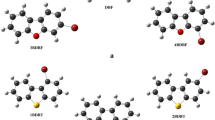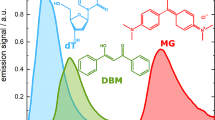Abstract
Accurate prediction of triplet excitation energies for transition metal complexes has proven to be a difficult task when confronted with a variety of metal centers and ligand types. Specifically, phosphorescent transition metal light emitters, typically based on iridium or platinum, often give calculated results of varying accuracy when compared to experimentally determined T1 emission values. Developing a computational protocol for reliably calculating OLED emission energies will allow for the prediction of a complex’s color prior to synthesis, saving time and resources in the laboratory. A comprehensive investigation into the dependence of the DFT functional, basis set, and solvent model is presented here, with the aim of identifying an accurate method while remaining computationally cost-effective. A protocol that uses TD-DFT excitation energies on ground-state geometries was used to predict triplet emission values of 34 experimentally characterized complexes, using a combination of gas phase B3LYP/LANL2dz for optimization and B3LYP/CEP-31G/PCM(THF) for excitation energies. Results show excellent correlation with experimental emission values of iridium and platinum complexes for a wide range of emission energies. The set of complexes tested includes neutral and charged complexes, as well as a variety of different ligand types.



Similar content being viewed by others
References
Adachi C, Baldo MA, Thompson ME, Forrest SR (2001) Nearly 100% internal phosphorescence efficiency in an organic light emitting device. J Appl Phys 90(10):5048–5051. doi:10.1063/1.1409582
Baldo MA, O’Brien DF, You Y, Shoustikov A, Sibley S, Thompson ME, Forrest SR (1998) Highly efficient phosphorescent emission fromorganic electroluminescent devices. Nature 395:151. doi:10.1038/25954
Baldo MA, Lamansky S, Burrows PE, Thompson ME, Forrest SR (1999) Very high-efficiency green organic light-emitting devices based on electrophosphorescence. Appl Phys Lett 75:4. doi: 10.1063/1.124258
Yasukawa N, Ikemizu D, Oshiyama T, Nishizeki M, Tanaka T (2012) Organic Electroluminescent Device, Display Apparatus, and Lighting Apparatus. United States Patent US20120018714A1
Kimyonok A, Domercq B, Haldi A, Cho J-Y, Carlise JR, Wang X-Y, Hayden LE, Jones SC, Barlow S, Marder SR, Kippelen B, Weck M (2007) Norbornene-based copolymers with iridium complexes and Bis(carbazolyl) fluorene groups in their side-chains and their use in light-emitting diodes. Chem Mater 19:5602–5608. doi:10.1021/cm0717357
Rausch AF, Murphy L, Williams JAG, Yersin H (2012) Improving the performance of Pt(II) complexes for blue light emission by enhancing the molecular rigidity. Inorg Chem 51:312–319. doi:10.1021/ic201664v
Solomatina AI, Krupenya DV, Gurzhiy VV, Zlatkin I, Pushkarev AP, Bochkarev MN, Besley NA, Bichoutskaia E, Tunik SP (2015) Cyclometallated platinum(II) complexes containing NHC ligands: synthesis, characterization, photophysics and their application as emitters in OLEDs. Dalton Trans 44(16):7152–7162. doi:10.1039/c4dt03106g
Shang X, Han D, Zhan Q, Zhang G, Li D (2014) DFT and TD-DFT study on the electronic structures and phosphorescent properties of a series of Heteroleptic iridium(III) complexes. Organometallics 33:3300–3308. doi:10.1021/om401194z
Xu S, Wang J, Xia H, Zhao F, Wang Y (2015) Computational prediction for emission energy of iridium (III) complexes based on TDDFT calculations using exchange-correlation functionals containing various HF exchange percentages. J Mol Model 21:22. doi:10.1007/s00894-014-2557-1
Tomasi J (2004) Thirty years of continuum solvation Chemistry: a review and prospects for the near future. Theor Chem Accounts 112(4):184–203. doi:10.1007/s00214-004-0582-3
Kolosov D, Adamovich V, Djurovich P, Thompson ME, Adachi C (2002) 1,8-Naphthalimides in phosphorescent organic LEDs: the interplay between dopant, Exciplex, and host emission. J Am Chem Soc 124:9945–9954. doi:10.1021/ja0263588
Ye S, Liu Y, C-a D, Xi H, Wu W, Wen Y, Lu K, Du C, Liu Y, Yu G (2009) Wide-energy-gap host materials for blue phosphorescent organic light-emitting diodes. Chem Mater 21:1333–1342. doi:10.1021/cm8032302
Niehaus TA, Hofbeck T, Yersin H (2015) Charge-transfer excited states in phosphorescent organo-transition metal compounds: a difficult case for time dependent density functional theory? RSC Adv 5:63318–63329. doi:10.1039/c5ra12962a
Frisch MJ, Trucks GW, Schlegel HB, Scuseria GE, Robb MA, Cheeseman JR, Scalmani G, Barone V, Mennucci B, Petersson GA, Nakatsuji H, Caricato M, Li X, Hratchian HP, Izmaylov AF, Bloino GZ J, Sonnenberg JL, Hada M, Ehara M, Toyota K, Fukuda R, Hasegawa J, Ishida M, Nakajima T, Honda Y, Kitao O, Nakai H, Vreven T, Montgomery JAJ, Peralta JE, Ogliaro F, Bearpark M, Heyd JJ, Brothers E, Kudin KN, Staroverov VN, Keith T, Kobayashi R, Normand J, Raghavachari K, Rendell A, Burant JC, Iyengar SS, Tomasi J, Cossi M, Rega N, Millam JM, Klene M, Knox JE, Cross JB, Bakken V, Adamo C, Jaramillo J, Gomperts R, Stratmann RE, Yazyev O, Austin AJ, Cammi R, Pomelli C, Ochterski JW, Martin RL, Morokuma K, Zakrzewski VG, Voth GA, Salvador P, Dannenberg JJ, Dapprich S, Daniels AD, Farkas O, Foresman JB, Ortiz JV, Cioslowski J, Fox DJ (2013) GAUSSIAN 09 (revision D.01). Gaussian Inc., Wallingford
Hohenberg P, Kohn W (1964) Inhomogeneous electron gas. Phys Rev 136(3B):B864–B871. doi:10.1103/PhysRev.136.B864
Fermi E (1928) Eine statistische Methode zur Bestimmung einiger Eigenschaften des Atoms und ihre Anwendung auf die Theorie des periodischen Systems der Elemente. Z Phys 48:73. doi:10.1007/BF01351576
Caillie CV, Amos RD (2000) Geometric derivatives of density functional theory excitation energies using gradient-corrected functionals. Chem Phys Lett 317(1–2):159–164. doi:10.1016/S0009-2614(99)01346-9
Stratmann RE, Scuseria GE, Frisch MJ (1998) An efficient implementation of time-dependent density-functional theory for the calculation of excitation energies of large molecules. J Chem Phys 109:8218–8224. doi:10.1063/1.477483
Scalmani G, Frisch MJ, Mennucci B, Tomasi J, Cammi R, Barone V (2006) Geometries and properties of excited states in the gas phase and in solution: theory and application of a time-dependent density functional theory polarizable continuum model. J Chem Phys 124:094107. doi:10.1063/1.2173258
Yersin H, Rausch AF, Czerwieniec R, Hofbeck T, Fischer T (2011) The triplet state of organo-transition metal compounds. Triplet harvesting and singlet harvesting for efficient OLEDs. Coord Chem Rev 255:2622–2652. doi:10.1016/j.ccr.2011.01.042
Yersin H (2008) Highly efficient OLEDs with phosphorescent materials. Wiley-VCH, Weinheim. doi:10.1002/9783527621309
Becke AD (1993) A new mixing of Hartree-Fock and local density-functional theories. J Chem Phys 98(2):1372–1377. doi:10.1063/1.464304
Adamo C, Barone V (1999) Toward reliable density functional methods without adjustable parameters: the PBE0 model. J Chem Phys 110(13):6158–6170. doi:10.1063/1.478522
Perdew JP, Burke K, Ernzerhof M (1996) Generalized gradient approximation made simple. Phys Rev Lett 77(18):3865–3868. doi:10.1103/PhysRevLett.77.3865
Jacquemin D, Perpete EA, Ciofini I, Adamo C, Valero R, Zhao Y, Truhlar DG (2010) On the performances of the M06 family of density functionals for electronic excitation energies. J Chem Theory Comp 6(7):2071–2085. doi:10.1021/ct100119e
Zhao Y, Truhlar DG (2008) Density functionals with broad applicability in chemistry. Acc Chem Res 41(2):157–167. doi:10.1021/ar700111a
Zhao Y, Truhlar DG (2006) A new local density functional for main-group thermochemistry, transition metal bonding, thermochemical kinetics, and noncovalent interactions. J Chem Phys 125:194101. doi:10.1063/1.2370993
Zhao Y, Truhlar DG (2008) The M06 suite of density functionals for main group thermochemistry, thermochemical kinetics, noncovalent interactions, excited states, and transition elements: two new functionals and systematic testing of four M06-class functionals and 12 other functionals. Theor Chem Accounts 120:215–241. doi:10.1007/s00214-007-0310-x
Beck AD (1988) Density-fnnctional exchange-energy approximation with correct asymptotic behavior. Phys Rev A 38(6):3098–3100. doi:10.1103/PhysRevA.38.3098
Perdew JP (1986) Density-functional approximation for the correlation energy of the inhomogeneous electron gas. Phys Rev B 33(12):8822–8824. doi:10.1103/PhysRevB.33.8822
Yanai T, Tew DP, Handy NC (2004) A new hybrid exchange–correlation functional using the coulomb-attenuating method (CAM-B3LYP). Chem Phys Lett 393:51–57. doi:10.1016/j.cplett.2004.06.011
Peverati R, Truhlar DG (2011) Improving the accuracy of hybrid meta-GGA density functionals by range separation. J Phys Chem Lett 2:2810–2817. doi:10.1021/jz201170d
Chai J-D, Head-Gordon M (2008) Long-range corrected hybrid density functionals with damped atom–atom dispersion corrections. Phys Chem Chem Phys 10:6615–6620. doi:10.1039/b810189b
Stevens WJ, Basch H, Krauss M (1984) Compact effective potentials and efficient shared-exponent basis sets for the first- and second-row atoms. J Chem Phys 81(12):6026–6033. doi:10.1063/1.447604
Hay PJ, Wadt WR (1985) Ab initio effective core potentials for molecular calculations. Potentials for K to au including the outermost core orbitals. J Phys Chem 82(1):299–310. doi:10.1063/1.448975
Hay PJ, Wadt WR (1985) Ab initio effective core potentials for molecular calculations. Potentials for the transition metal atoms Sc to Hg. J Phys Chem 82(1):270–283. doi:10.1063/1.448799
Hay PJ, Wadt WR (1985) Ab initio effective core potentials for molecular calculations. Potentials for main group elements Na to Bi. J Phys Chem 82(1):284–298. doi:10.1063/1.448800
Jr THD, Hay PJ (1977) Modern theoretical chemistry, vol 3. Plenum, New York
Francl MM, Pietro WJ, Here WJ, Binkley JS, Gordon MS (1982) Self-consistent molecular orbital methods. XXIII. A polarization-type basis set for second-row elements. J Chem Phys 77(7):3654–3665. doi:10.1063/1.444267
Herre WJ, Ditchfield R, Pople JA (1972) Self-consistent molecular orbital methods. XII. Further extensions of Gaussian-type basis sets for use in molecular orbital studies of organic molecules. J Chem Phys 56(5):2257–2261. doi:10.1063/1.1677527
Krishnan R, Binkley JS, Seeger R, Pople JA (1980) Self-consistent molecular orbital methods. XX. A basis set for correlated wave functions. J Chem Phys 72(1):650–654. doi:10.1063/1.438955
McLean AD, Chandler GS (1980) Contracted Gaussian basis sets for molecular calculations. I. Second row atoms, Z=11-18. J Chem Phys 72(10):5639–5648. doi:10.1063/1.438980
Cances E, Mennucci B, Tomasi J (1997) A new integral equation formalism for the polarizable continuum model: theoretical background and applications to isotropic and anisotropic dielectrics. Chem Phys 107(8):3032–3041. doi:10.1063/1.474659
Tomasi J, Mennucci B, Cancès E (1999) The IEF version of the PCM solvation method: an overview of a new method addressed to study molecular solutes at the QM ab initio level. J Mol Struct (THEOCHEM) 464(1–3):211–226. doi:10.1016/S0166-1280(98)00553-3
Marenich AV, Cramer CJ, Truhlar DG (2009) Universal solvation model based on solute electron density and on a continuum model of the solvent defined by the bulk dielectric constant and atomic surface tensions. J Phys Chem B 113(18):6378–6396. doi:10.1021/jp810292n
Sajoto T, Djurovich PI, Tamayo AB, Oxgaard J, III WAG, Thompson ME (2009) Temperature dependence of blue phosphorescent cyclometalated Ir(III) complexes. J Am Chem Soc 131(28):9813–9822. doi:10.1021/ja903317w
Adachi C, Kwong RC, Djurovich P, Adamovich V, Baldo MA, Thompson ME, Forrest SR (2001) Endothermic energy transfer: a mechanism for generating very efficient high-energy phosphorescent emission in organic materials. Appl Phys Lett 79(13):2082–2084. doi:10.1063/1.1400076
Chiu Y-C, Chi Y, Hung J-Y, Cheng Y-M, Yu Y-C, Chung M-W, Lee G-H, Chou P-T, Chen C-C, Wu C-C, Hsieh H-Y (2009) Blue to true-blue phosphorescent IrIII complexes bearing a Nonconjugated ancillary phosphine chelate: strategic synthesis, photophysics, and device integration. ASC Appl Mater Interfaces 1(2):433–442. doi:10.1021/am800122n
Lee SJ, Park K-M, Yang K, Kang Y (2009) Blue phosphorescent Ir(III) complex with high color purity: fac-Tris(2′,6′-difluoro-2,3′-bipyridinato-N,C4’) iridium(III). Inorg Chem 48(3):1030–1037. doi:10.1021/ic801643p
Tordera D, Serrano-Pérez JJ, Pertegás A, Ortí E, Bolink HJ, Baranoff E, Nazeeruddin MK, Frey J (2013) Correlating the lifetime and fluorine content of iridium(III) emitters in green light-emitting electrochemical cells. Chem Mater 25:3391–3397. doi:10.1021/cm402473j
Li H, Yin Y-M, Cao H-T, Sun H-Z, Wang L, Shan G-G, Zhu D-X, Su Z-M, Xie W-F (2014) Efficient greenish-blue phosphorescent iridium(III) complexes containing carbene and triazole chromophores for organic light-emitting diodes. J Organometallic Chem 753:55–62. doi:10.1016/j.jorganchem.2013.11.036
Brooks J, Babayan Y, Lamansky S, Djurovich PI, Tsyba I, Bau R, Thompson ME (2002) Synthesis and characterization of phosphorescent Cyclometalated platinum complexes. Inorg Chem 41(12):3055–3066
Ravindranathan D, Vezzu DAK, Bartolotti L, Boyle PD, Huo S (2010) Improvement in phosphorescence efficiency through tuning of coordination geometry of tridentate Cyclometalated platinum(II) complexes. Inorg Chem 49(19):8922–8928. doi:10.1021/ic101109h
Vezzu DAK, Ravindranathan D, Garner AW, Bartolotti L, Smith ME, Boyle PD, Huo S (2011) Highly luminescent tridentate N∧C*N platinum(II) complexes featured in fused five-six-membered metallacycle and diminishing concentration quenching. Inorg Chem 50:8261–8273. doi:10.1021/ic200794b
Fleetham T, Li G, Wen L, Li J (2014) Effi cient “pure” blue OLEDs employing Tetradentate Pt complexes with a narrow spectral bandwidth. Adv Mater 26:7116–7121. doi:10.1002/adma.201401759
Hudson ZM, Sun C, Helander MG, Amarne H, Lu Z-H, Wang S (2010) Enhancing phosphorescence and electrophosphorescence efficiency of cyclometalated Pt(II) compounds with triarylboron. Adv Funct Mater 20:3426–3439. doi:10.1002/adfm.201000904
Acknowledgments
This work was supported by the Research Council of Norway (Grant No. 231706/F20 and No. 179568/V30), and from the Norwegian supercomputing program NOTUR (Grant No. NN4654K and NN93330K).
Author information
Authors and Affiliations
Corresponding author
Rights and permissions
About this article
Cite this article
Morello, G.R. Accurate prediction of emission energies with TD-DFT methods for platinum and iridium OLED materials. J Mol Model 23, 174 (2017). https://doi.org/10.1007/s00894-017-3348-2
Received:
Accepted:
Published:
DOI: https://doi.org/10.1007/s00894-017-3348-2




